My featured pic this week has nothing to do with the rest of the post, it was taken by our friend, Ben Brilhart, while we were in Home, AK a few weeks ago. Jo sent us a jump drive with a bunch of pics he took – he has an awesome camera with great lenses – and I decided to share this one since our Aurora Borealis pic wasn’t very good. Thanks Ben & Jo!
As I start this post, we have less than 3 weeks left til we lift our jacks for the last time at Renfros Lakeside Retreat. The thought of that both saddens and excites me. Sad to leave our beloved AK home, yet excited for what’s to come!
It’s been a quiet week this week. Bob & Marna left last week, and we moved up into their spot. We have a much larger side yard now! Mostly we moved b/c Gary shut off the RV Park wifi and we can use the lodge wifi from this site.
Census in the cabins and RV Park are both slowing down now, after Labor Day. Our work schedule has changed to accommodate Bob & Marna’s leaving, as well as the cabin schedule. We will have off Tuesday’s and Wednesday’s and our last day will be Monday, Sept 26, and we will more than likely leave on the 27th. Most of you will probably say – give yourself a day to rest, relax and leave the 28th – but I know myself well enough to know that anxiousness will take hold and we will hit the road the 27th.
So – the title of this post – Bill is taking care of replacing the shackles and doing another full inspection of the brakes and running gear. He has already changed the oil in the truck also.
On the inside, I attempted to do some purging of clothes, while taking out some colder weather items. Only half that was successful – winter clothes have been taken out and a lot of the short sleeves put away. The purge part – well – that didn’t go quite as planned. Seems I still like and/or feel the need to keep a lot of stuff. UGH!
On to the details of the shackle changing and running gear maintenance – a subject my lady readers will more than likely skip or simply share with their spouse, and my gentlemen readers will be like – YES!
First let me tell you why Bill decided to tackle this job. We have 2 friends of ours, Jim, of ExploRVistas , and Lee, of CamperChronicles , had theirs break. So, he inspected ours and noticed a little bit of play.
He then did a bunch of research on the whole thing and decided to replace ours. Getting these parts up here in AK has proven to be more difficult than it should be. First he was going to order them from Amazon, as they had the best price, but they would NOT ship them up here – even after 2 lengthy phone calls we still don’t know why. Then he looked on ETrailer, we’ve bought things from them in the past and they’ve always been great to deal with. ETrailer would NOT ship them up here either. Then he tried PPL and a few others, who would ship the parts but the cost for said shipping was crazy high – between $80 and $100 due to the weight. Just the weight of the shackles wasn’t too bad, but you can’t buy just the shackles, you have to get a kit, which includes stuff he didn’t need. Longer story shorter, he ended up buying from Amazon, using free shipping to send it to our home address in FL (my parents) and having them send it to us in a flat rate USPS box. Took 4 days to get here, the medium box cost $13’ish to send. Problem solved! How crazy was that!?
We now have the parts! Whew!
Parts and tool list:
Heavy duty shackles, bushings and wet bolts
Hi-Temp multi-purpose grease – Bill likes Mystik JT6 (this is one recommended by Dexter)
Misc sockets, jack, torque wrench, screw driver, blocking, seal puller
Never Seize hi-temp brake grease
First thing to do is put wood under the trailer leveling jacks to give more lift so he could get the tires off the ground, as well as for extra stability. Then he used the truck jack under the axle to take the axle weight off the shackles.
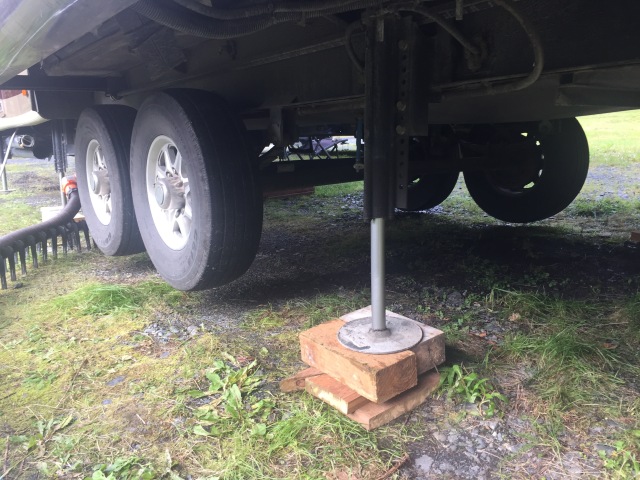
He then took the first wheel off. He left the other wheel on just in case something happened, the tire could support the trailer. Next step was removing the dust cap, locking clip (which he prefers over the sometimes used cotter pin), then off comes the ‘D’ washer.
The “D” style locking clip, way better the messing with a cotter pin!
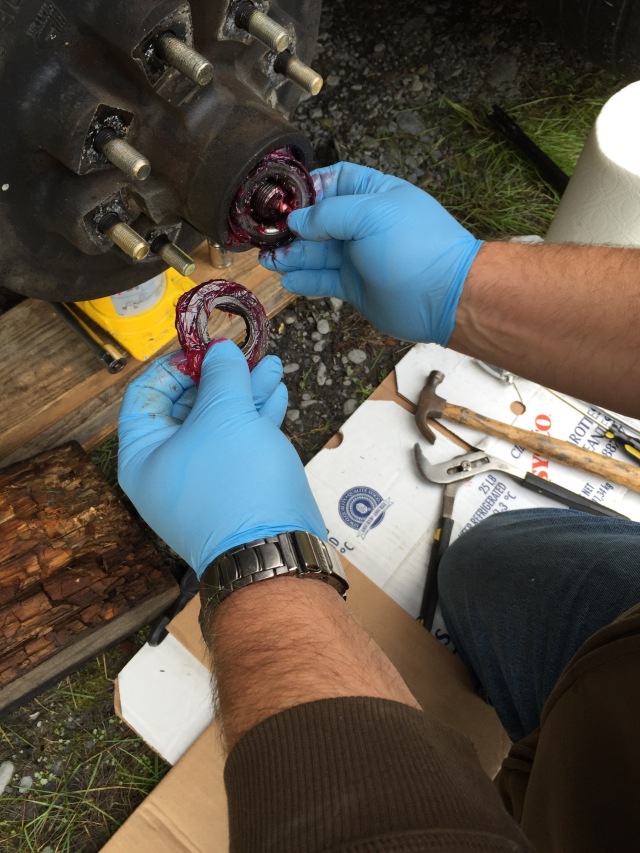
Next remove the D ring and the small wheel bearing.
Then he pulled the hub off.
He purchased a special tool, a seal puller, to remove the grease seal, then the larger wheel bearing comes out.

The grease that looks black and muddy is worn and dirty and needs to be replaced. Next he cleaned the bearings and races to remove the old grease so he could inspect them. When looking at them, he was looking for scoring.
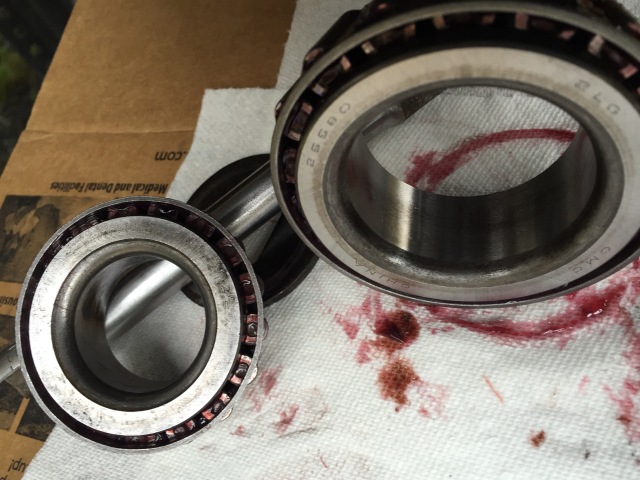
Inner bearing surfaces look pretty good other than some light scorching.

Races look perfect.
Next he repacked the bearings with grease, pushing the new grease in until all old grease comes out the other side. Last time he cleaned them with solvent, which he did b/c he didn’t know what kind of grease they came from the factory with and he didn’t want to mix different kinds of grease, as they aren’t all compatible.

As a side story, Bill was telling me about how the technology used in these trailers is very old, the same that was used on his ’68 Mustang back in the day. He also was commenting that young, new mechanics don’t even know how to repack bearings since new cars come with unserviceable bearings.
Bill then used brake cleaner spray to clean the dust off the drum/hub braking surfaces so he could inspect it. He was looking for scoring, and checking the face of the drum for scoring also, as this is where the magnet travels.

He also needed to clean, still using the spray brake cleaner, the brake shoes, hardware and backing plate.
Now it was time to check the brake shoes for wear/thickness. Ours wore about 1mm in the last 10,000 miles since he’s checked them last, so they didn’t need to be replaced. They are between 4 and 5mm – anything less than 2mm and he would have wanted to replace them.
The self-adjusting mechanism needs to be inspected and lubricated if necessary. Basically you have to spin it and if it turns freely, it’s ok. Next you have to lubricate it b/c you’ve cleaned all the grease off with brake cleaner to inspect it. You also have to lubricate the 6 contact points between the brake shoe and backing plate. These items need to be lubricated with a high temp brake lubricant such as Never Seize. This step is often skipped and is necessary to keep your brakes quiet and protect the backing plate.
When reassembling, Bill was sure to torque the axle nut to 50 foot pounds while spinning the hub, this seats the bearing in the race. Then, loosen the nut carefully and tighten finger right.
This is the new style Dexter seal that has the sealant already on the seal. The last time he had to add the sealant separate.
Adding grease the the race before dropping the bearing in place.
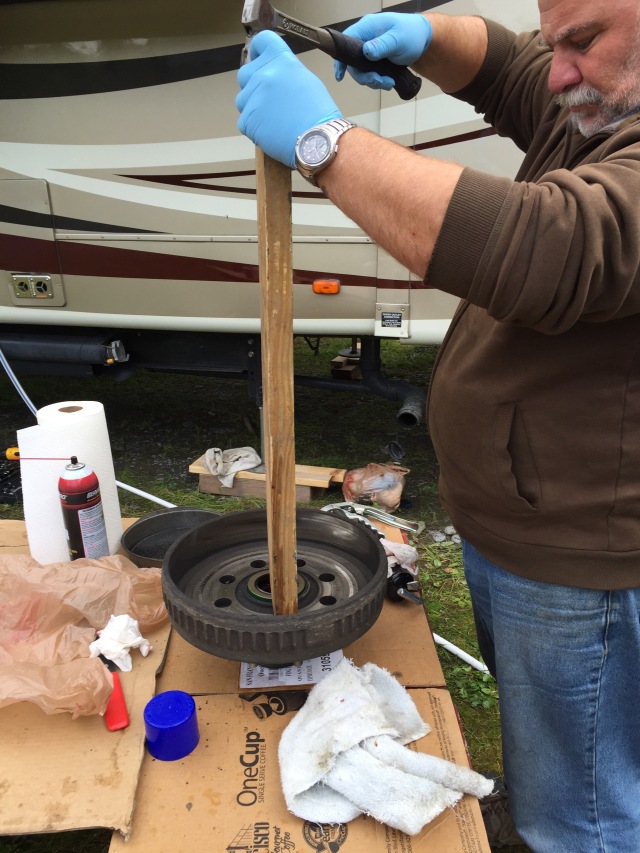 Gently tap grease seal into place being careful not to bend it!
Gently tap grease seal into place being careful not to bend it!
He now had completed this wheel position! One down – 3 to go!
One of the remaining grease seals failed. Grease just started to migrate onto the brakes. Bill suspects this is from when he greased the wheel bearings in Bellingham. With the EZ lube bearings you can add grease without taking the assembly apart BUT the wheels should be spinning when adding grease. A small tidbit he learned after the fact.
Grease on top corner of brakes, NOT good.
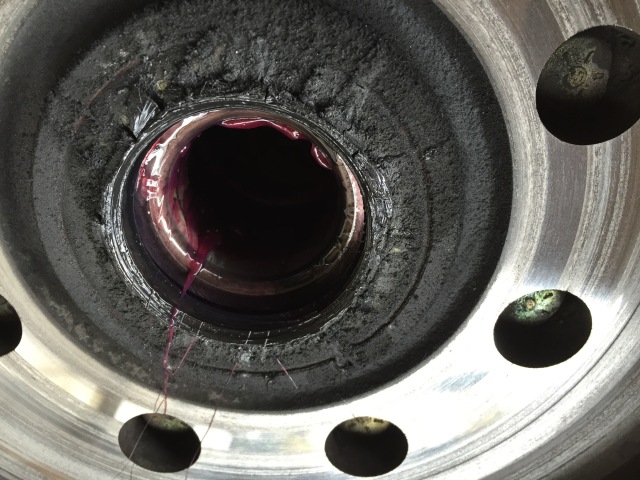
Lots of grease where it does not belong

See the small hole in the upper left of the spindle. This is where the grease goes with the EZ lube system. If you are not rotating the tire while greasing the grease may find an easier path through the back of the grease seal. Lesson learned, add grease slowly while rotating the wheel.
Next up was the shackles! Ready?
This shackle is worn. See the small area on the bottom bolt near the top that is clean. That is from bolt movement. Not good. You can inspect for wear by tapping the bolts with a hammer when the wheel is off the ground. It should not move. One of ours was moving 3/16″!
The first thing you do is raise the trailer the same way as above and place jack under axle and take the weight off the suspension. Next loosen the bolts that attach the shackles to the leaf spring and equalizer. You may have to lower or raise the jack to take off the pressure so you can tap out the bolts with a hammer. Now you can remove them,

The new shackles are twice as thick as the old ones!
Next you have to remove the old nylon bushings by tapping them out with a socket or punch. Some may have bronze already. Either way they need to be inspected and replaced if necessary. Our nylon bushings were toast!
Here is the old nylon bushing next to the new bronze bushing,
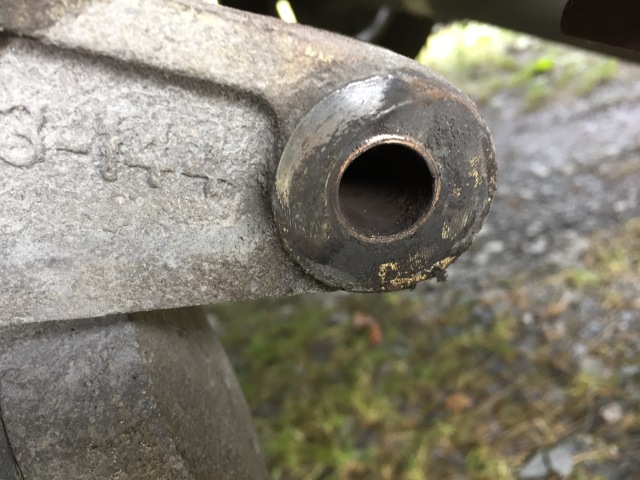
This is the bronze bushing in the equalizer. It looks great after 22K miles and didn’t even have a wet bolt. Bronze looks to be superior to Nylon. Bill found out when researching the parts that our equalizer is rated for 8K pound axles, Awesome!
Next you tap in the new Bronze bushing carefully with a hammer of piece of wood.
Next you attach the shackles and install the bolts. The bolts need to be torqued to 50 foot pounds. NOTE: Our axles have a wide spacing so we will be able to grease them easily with the wheels on. Some units have narrow spacing. The narrow spaced units will probably have an easier time putting the zerks facing the inside.
Now you can grease the bolts. Make sure the grease hole in the bolt is NOT at 12 or 6 O’clock as the weight of the trailer may prevent the grease from entering the bolt.
Might as well grease the equalizer as well.
You can mark the bolts where the grease hole is to install correctly. Continuing the line onto the shackle you can have a reference point to make sure the captured bolt has not slipped. This is a sign of early wear! You can also use a punch to mark them.
Remember the 3/16″ of play. This is what that looks like when removed!
You can see how the ribs have worn off the bolt on the left. The bolt is normally captured in the shackle by these ribs and cannot move.
Job complete, just need to do the other side.
NOTES:
Running gear maintenance needs to be done at least every 10K miles or annually (This is what Dexter recommends), especially if your rig is anywhere near its GVWR. Check your owners manual.
If you are not comfortable with this type of work you should pay someone to do it for you, its important! A full running gear inspection with wheel bearing repack should cost around $100 to $200 per axle. Labor to replace shackles should run about $100 per side. The parts cost about $125.
Bottom line we saved at least $400 and learned what to watch for in the future.
Not sure if any of you noticed, but Bill ended up typing a good bit of this post, as it was becoming crazy, him trying to recite it to me what he did. Not that it matters, but just wanted to mention it. First time for that!
I will post again soon – with plenty of pretty pics of pretty vistas – like mountains and other things!


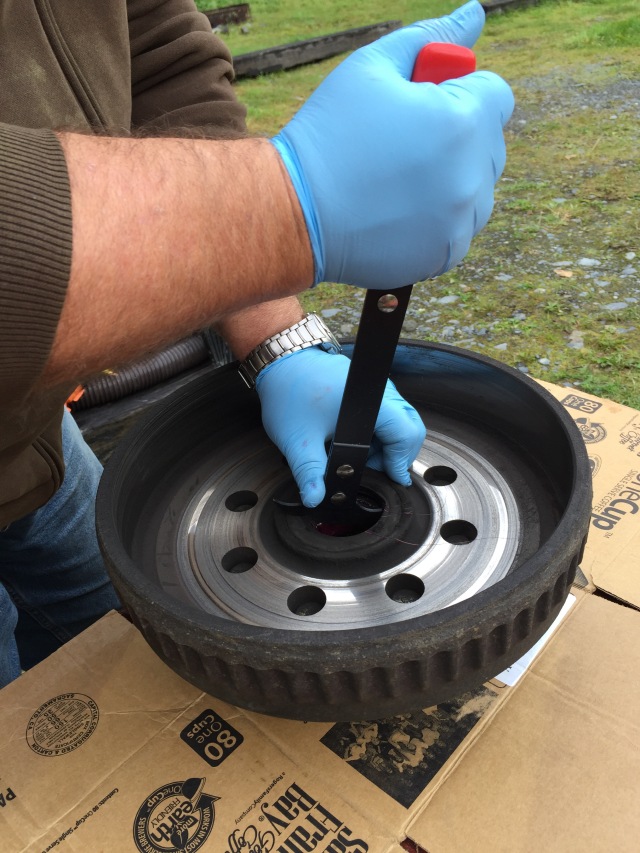
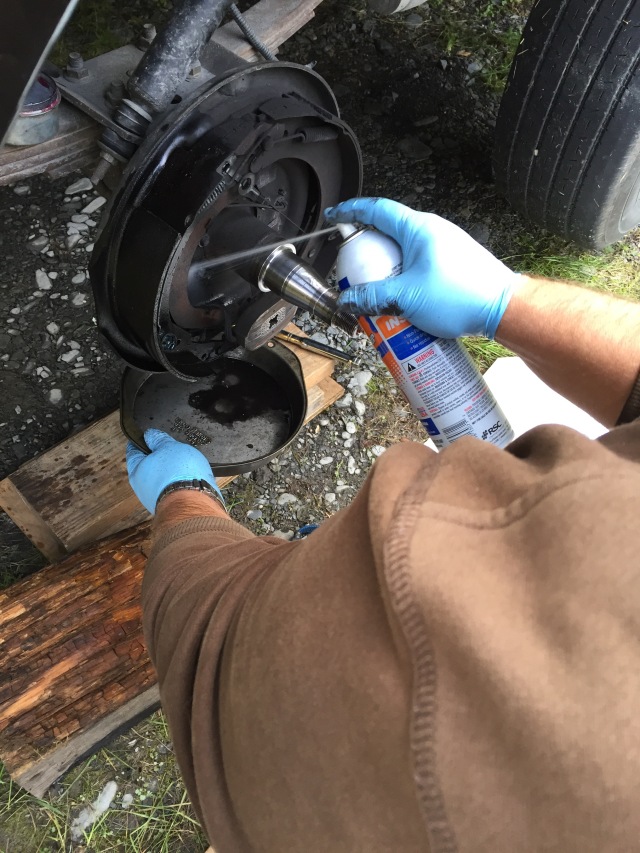
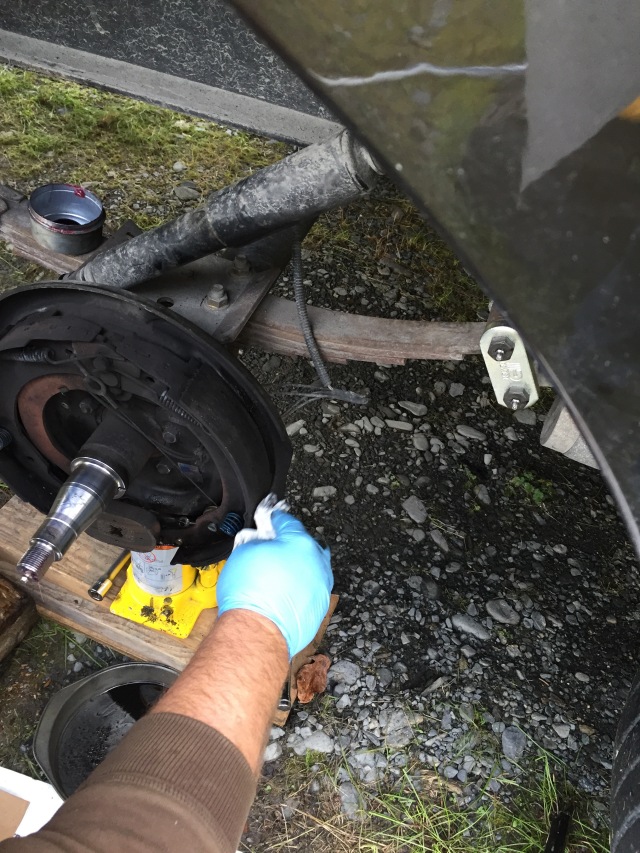


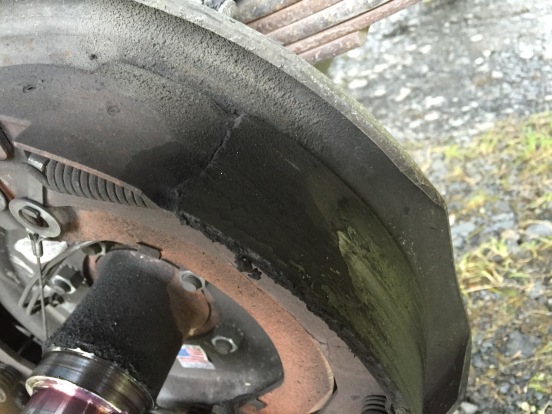
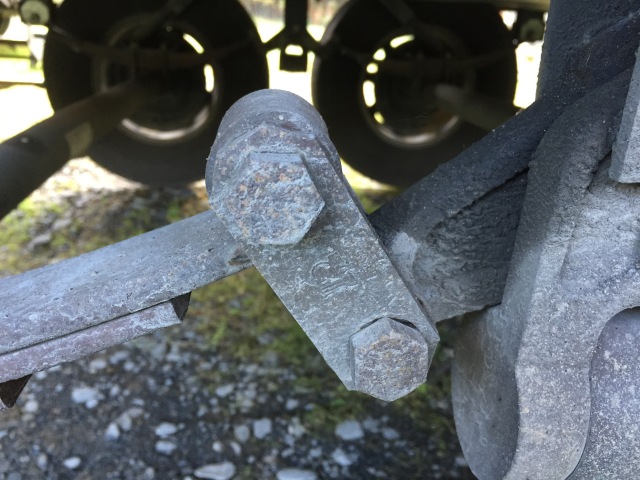
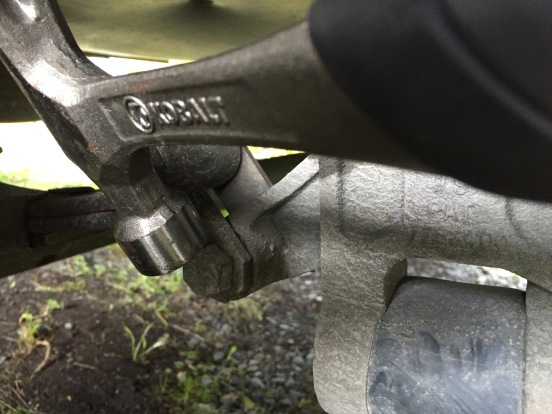
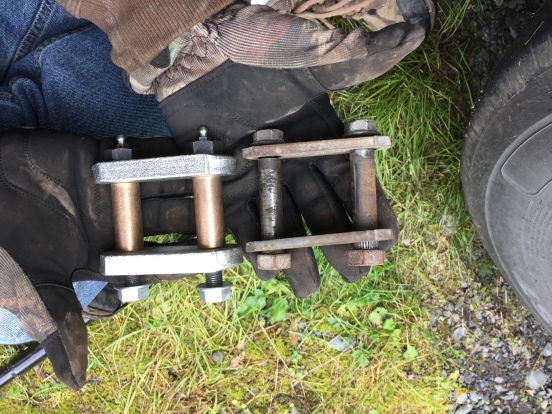
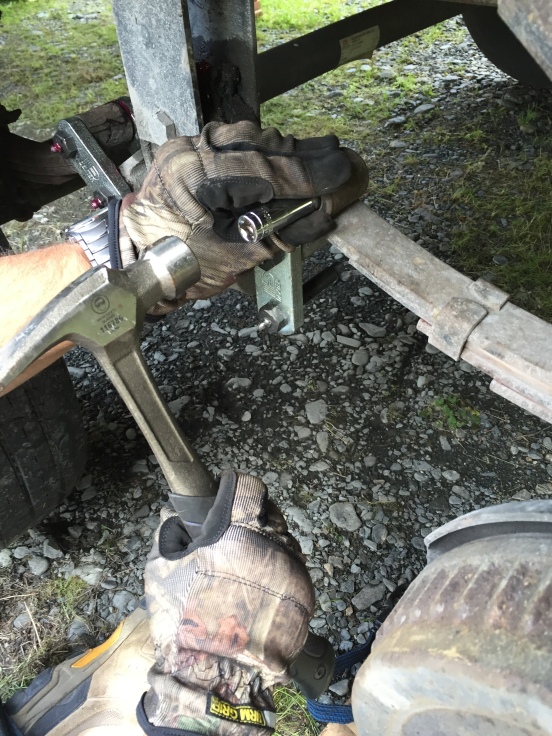
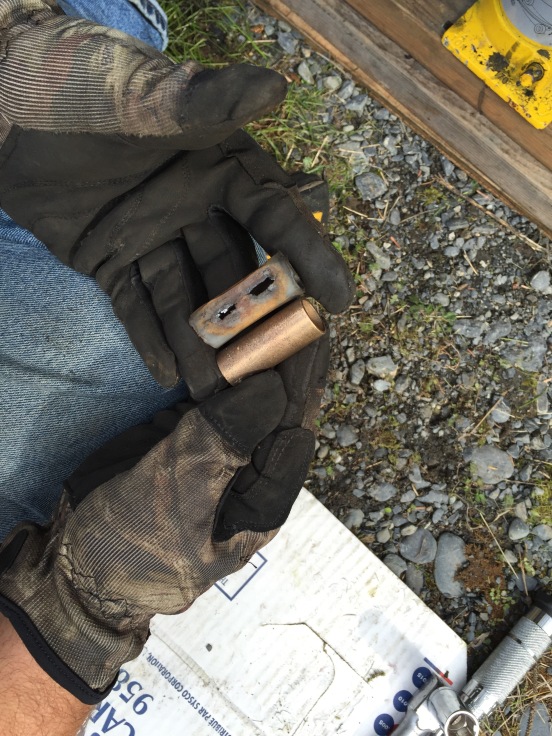
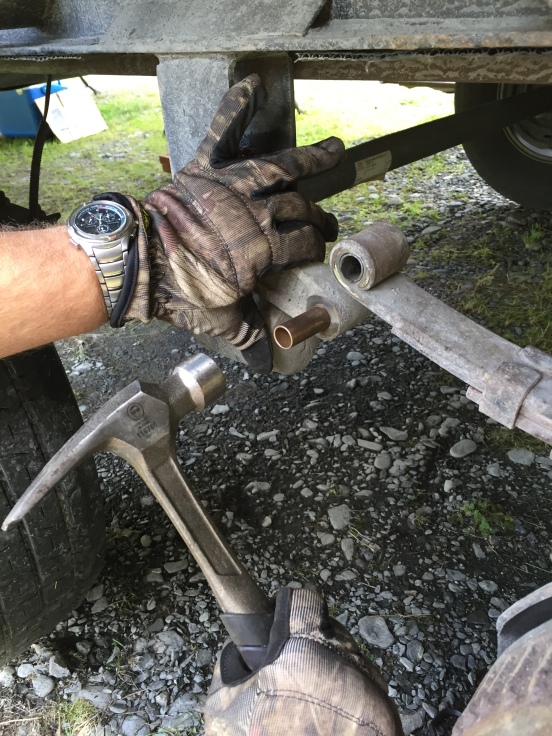
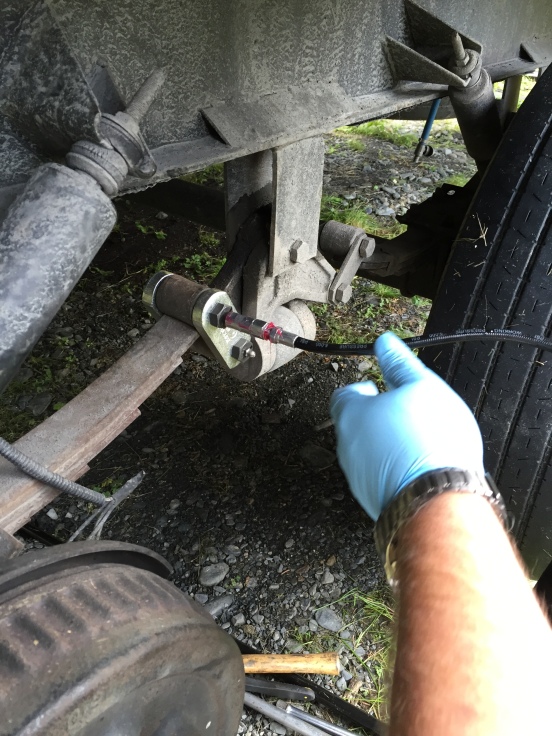
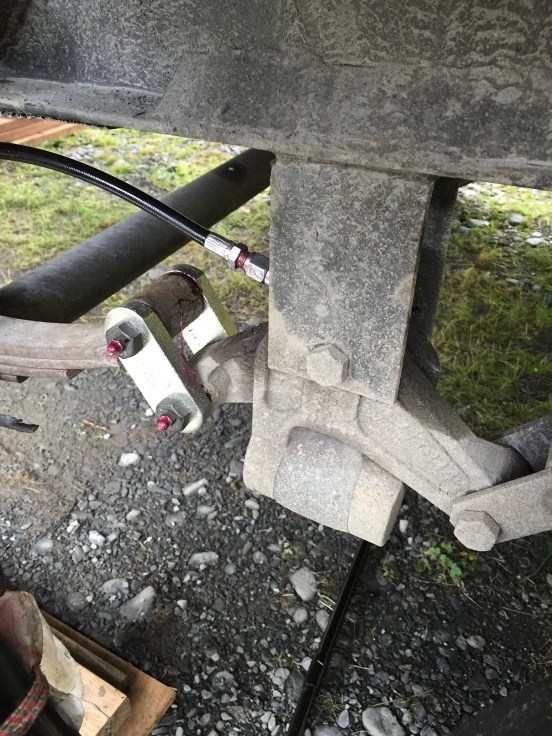
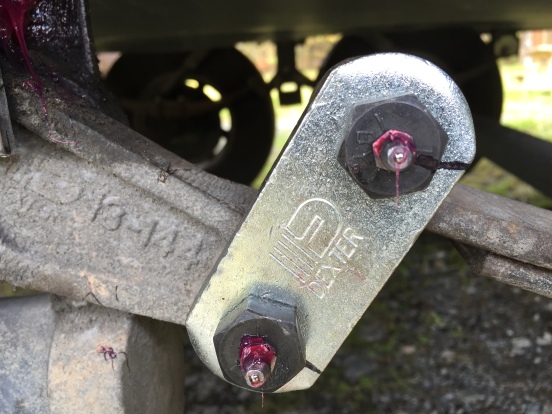
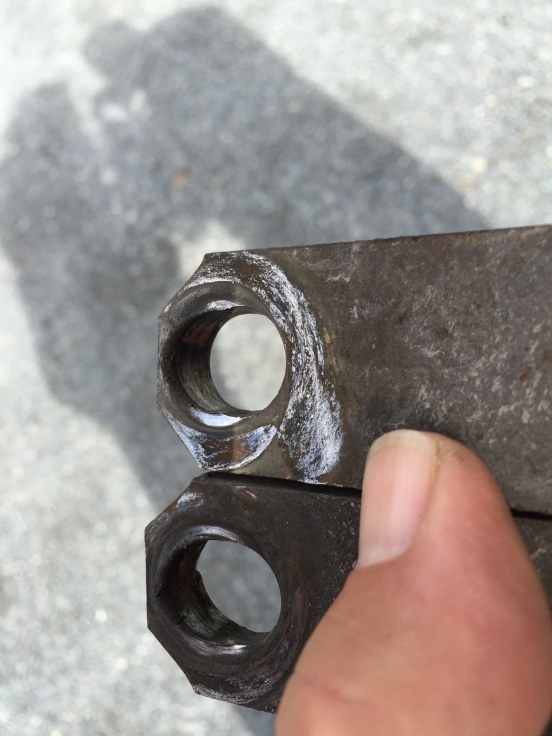
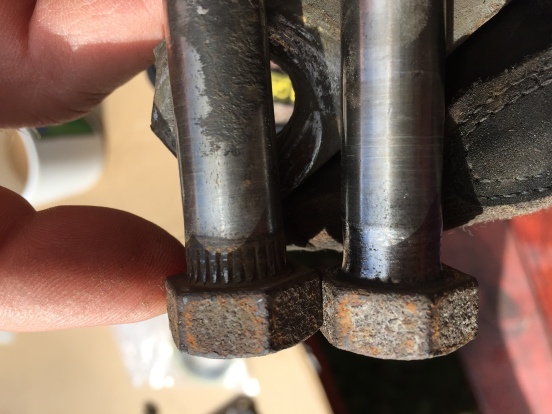
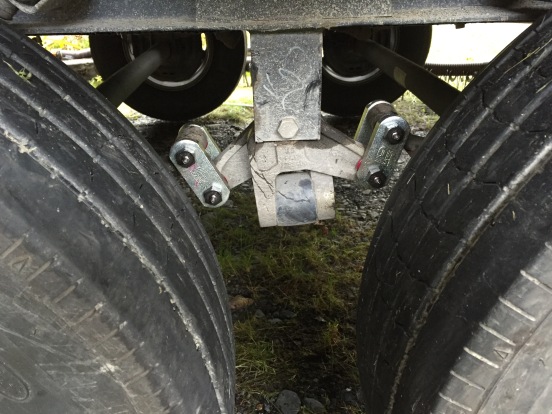
On the snow bird network you could make a million as a reality show! Have to figure how to bring this mainstream.
When you figure that out – let me know!
Oh man….those old shackles wouldn’t have made it back to the lower 48. So glad you replaced them when you did! Wet bolts should be standard equipment, in my opinion. And yes…Bill did that replacement ‘by the book’; each and every step is important. Great post, Kelly and Bill!
Thanks Jim! Bill is of the mind – if you are going to do it – do it right! Wanted to pass it along to help others avoid an issue – since we’ve learned from others before us!
Interesting read. And not just the men enjoy it. Women do the work too thank you.
Good for you Lisa – I’m glad you do the work as well – I’m pretty useless except for taking the pics and grabbing a wrench or screwdriver then needed! Thanks for reading!
Excellent post! As you know we, we know all about those wet bolts and shackles after our debacle in the AZ desert with a sheared wet bolt on the leaf spring hanger.
Good thing you decided to change them out.
Just keep inspecting them every so often.
Safe travels and see you down the road!
Les and Sue
I forgot all about your problem Les! Bill inspects all areas periodically! Have fun at Amazon and hopefully paths will cross soon!
Even though I will probably never do this, I found it fascinating. Great job capturing the step by steps with pics and explaining it in such a way that even the non-mechanically minded like myself can figure it out!!
Thanks! Even I understood most of it this time! I’m just glad it’s done – it could have been a big problem if they had broken on the way out of here!
Nice post. I tried doing our shackles in Moab last spring. I just didn’t have the right tools at the time. In the Air Force I would have had to write Bill up for tool abuse. Pounding on a socket with a hammer. Drop and give me fifty!
I’d love to see that – Bill doing 50!?! It’s been YEARS! He says what you say is true – but sometimes you just gotta improvise!
Bill, you are the MAN! So glad you tackled this job before your trip south. The only thing in all those photos I recognized was the red grease. Remember in Watson Lake when Steven stepped on a tube of it and tracked it into Scoopy? Ugh, we’re still trying to get rid of those spots!
I am so glad he did it as well! It would have been UGLY if one or more of those things had snapped on the way out! I didn’t realize that’s what he stepped on! UGH – it is a sticky nasty mess! Poor Scoopy! Thankfully you guys don’t have to worry about such things!
Excellent post and a great reminder to check that running gear.
Thanks Shawn! We’ve been reminded by others and wanted to pay it forward!
Great step by step process Bill. You just reminded me that it’s time to get ours inspected.
Glad to help!
Great post! Not something I would tackle (unless Bill was standing over my shoulder), but really enjoyed the step-by-step process.
Thanks Gene! Not sure you have shackles – but if you do and need to replace/upgrade them – Bill says he will gladly stand by to help! Miss you guys! Hope to see you in FL!
We’ll be in Florida on Nov 1st. Let us know where you’re staying.
Thank you for the great explanation of each step. I learned a lot about what all those parts are others, to include manufacturers, are talking about. Such as I never knew what they meant by bronze bushings but now know the difference.
You are very welcome! This is how we learn best! From each other!
Okay I’ll admit it straight up, I’m a mechanical virgin (relatively speaking. I’ve done minor things but nothing on that scale. and yet I am not afraid of trying it.
I’m pretty handy and take to such technical things pretty quickly, around the house I’ve framed and finished a full basement including wiring it all up to code, plumbed a whole house water filtration and softener system, built a deck, repaired appliances and more so I’m not just intellectually minded.
I’ve never done a brake job let alone suspension work. Decades ago in my more adventurous youth I did undertake a new intake manifold and Holly 680 CFM carburetor on a 1976 Chev Monza with V8 under the hood. It went well but ever since I haven’t done any auto mechanical stuff other than a few oil changes, filter replacements, spark plugs and wires and A/C service.
So as we approach our RV time and with the likelihood of having the available time to perform the work, I’ve begun reading up and watching YT on such items. I’m pretty sure I could handle it but without a knowledgeable “supervisor” showing me the ropes and looking over my shoulder, I’ll likely pay to have it done though I’d rather not and save the money. I guess I stumble on which is a good use of my time and energy vs better let a pro do it.
What I need is a mentor. I enjoyed your “tutorial” Bill. If we are nearby and you have maintenance to perform and don’t mind an “apprentice”, I’ll supply the liquid refreshments of your choice just for a front row seat and will even get my hands dirty. (Actually kind of hoping for it.) Geeky stuff is fun too Kelly. LOL
I’ll (Kelly) have Bill send his own reply – but I think it’s a safe bet that if liquid ADULT refreshments were supplied – you’d have a deal! Having said that – I’ll leave the “geeky” stuff to the “geeks”! Ha!
Brian – I (Kelly) spoke to Bill and he said to tell you my initial reply was spot-on – he says it sounds like you have more than enough ability to “get it.” He’s always up for a helper and/or “mentee” – he actually loves and enjoys it! His favorite day of installs is teaching the client about their new system! So – no worries – Bill’s got your back!